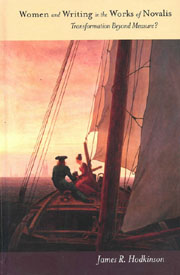Book contents
- Frontmatter
- Contents
- Acknowledgments
- Abbreviations of Major Primary Works Cited
- Typological Conventions in Novalis: Schriften
- Introduction
- 1 Writing in Context: Romanticism, Gender, and the Case of Novalis
- 2 Writing about Women, 1795–99
- 3 Esteem and the Epistolary: Hardenberg and Women of Letters
- 4 Music and the Manifold of Voices: The Subject and the Theory of Polyphony, 1797–99
- 5 From Music to Metamorphosis: Women's Role and Writing in Heinrich von Ofterdingen, 1798–1801
- 6 “Freyes Fabelthum”: The Poetic Construction of Gender in Hardenberg's Religious Writing
- Conclusion: Progression, Reaction, and Tension in Hardenberg's Gender Writing
- Works Consulted
- Index
1 - Writing in Context: Romanticism, Gender, and the Case of Novalis
Published online by Cambridge University Press: 05 February 2013
- Frontmatter
- Contents
- Acknowledgments
- Abbreviations of Major Primary Works Cited
- Typological Conventions in Novalis: Schriften
- Introduction
- 1 Writing in Context: Romanticism, Gender, and the Case of Novalis
- 2 Writing about Women, 1795–99
- 3 Esteem and the Epistolary: Hardenberg and Women of Letters
- 4 Music and the Manifold of Voices: The Subject and the Theory of Polyphony, 1797–99
- 5 From Music to Metamorphosis: Women's Role and Writing in Heinrich von Ofterdingen, 1798–1801
- 6 “Freyes Fabelthum”: The Poetic Construction of Gender in Hardenberg's Religious Writing
- Conclusion: Progression, Reaction, and Tension in Hardenberg's Gender Writing
- Works Consulted
- Index
Summary
Gender and Writing: Women on the Cultural Landscape around 1800
LITERARY SCHOLARS CONTINUE to return to the Romantic period, considering it from new perspectives and reopening older debates. There is a debate on the relationship, both intellectual-historical and aesthetic, between the Romantic “macro-epoch” and the earlier Enlightenment, with both continuities and discontinuities between the two being mooted. There is also a debate on the structure of Romanticism itself, such that traditional distinctions between the movement's micro-epochs, between the revolutionary project of the Early Romantics and the skeptical, “reactionary” tendencies of the Late Romantics, have been in dispute.
Such diversity of opinion also characterizes assessments of the Romantic treatment of gender issues. The Romantic tradition of venerating the feminine, traditionally taken at face value, was unmasked by the political feminism of the 1970s as a practice in fact projecting patriarchal ideals and fantasies of women in word and image. This view was revised by other feminists of the mid 1980s and 1990s who, working in the French gynocentric tradition, sought to reclaim these portrayals of femininity as important sources of female power within canonical literature. The discussion of gender in the literary canon was not, however, limited to analyses of the images of femininity within male-authored texts, but has sought to reconstruct the position of women writers at the margins of the literary canon. The Romantic period is traditionally thought of as the period in which women wrote in greater quantities and more openly than they had hitherto and, significantly, began to publish.
- Type
- Chapter
- Information
- Women and Writing in the Works of NovalisTransformation beyond Measure?, pp. 24 - 56Publisher: Boydell & BrewerPrint publication year: 2007



